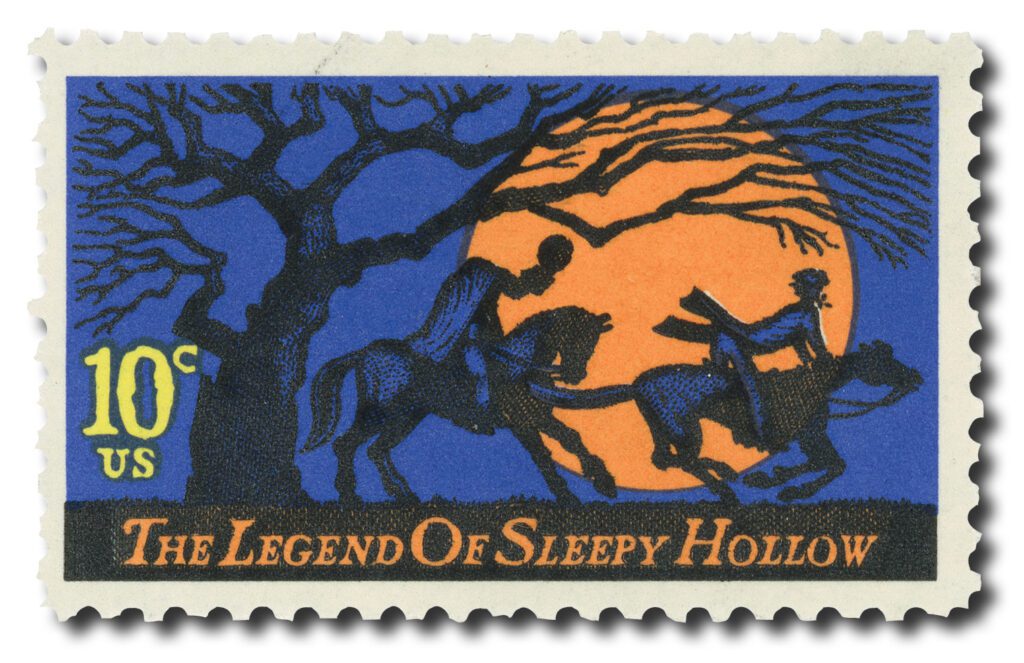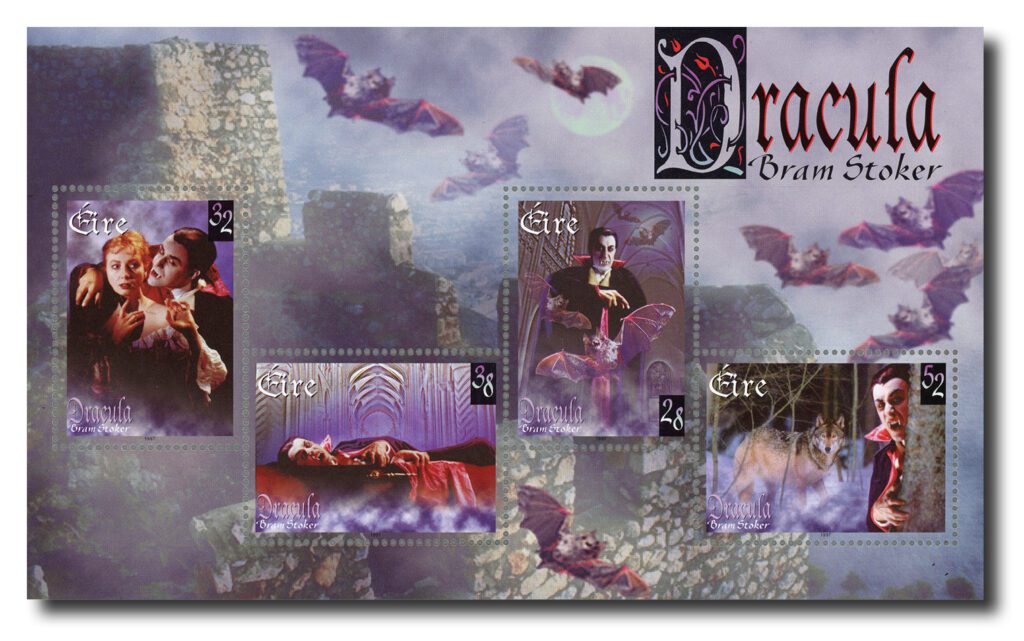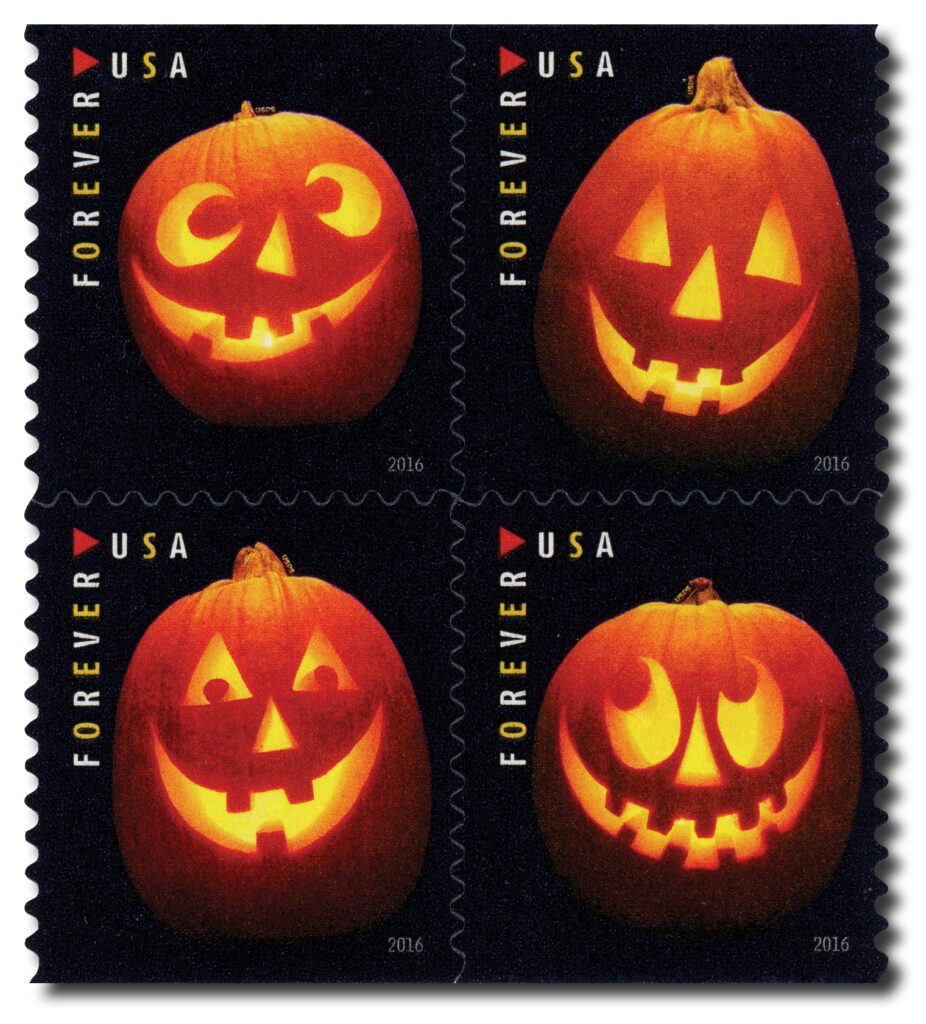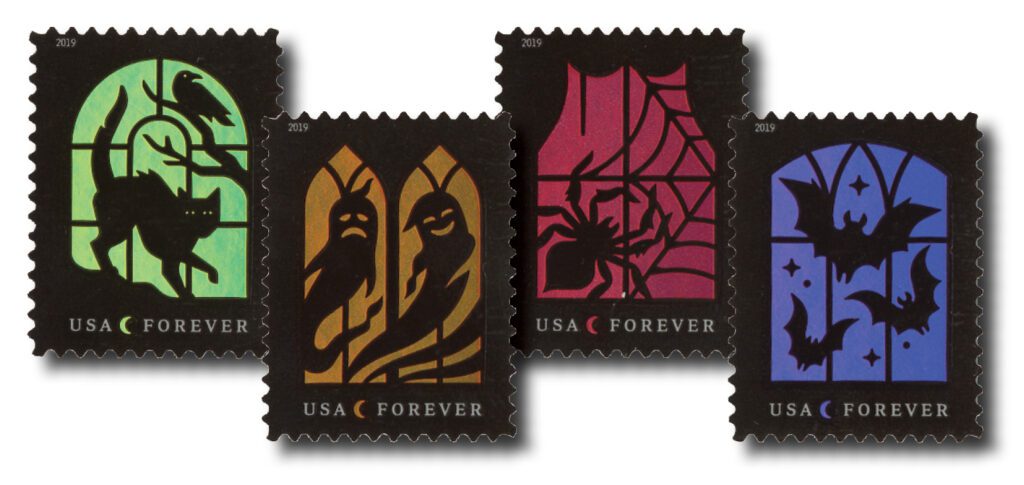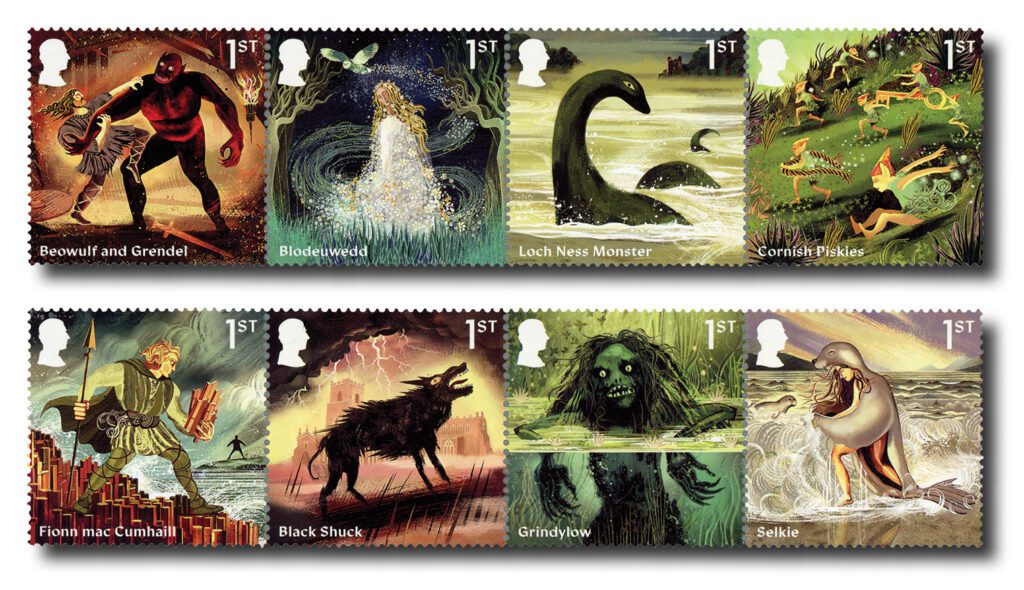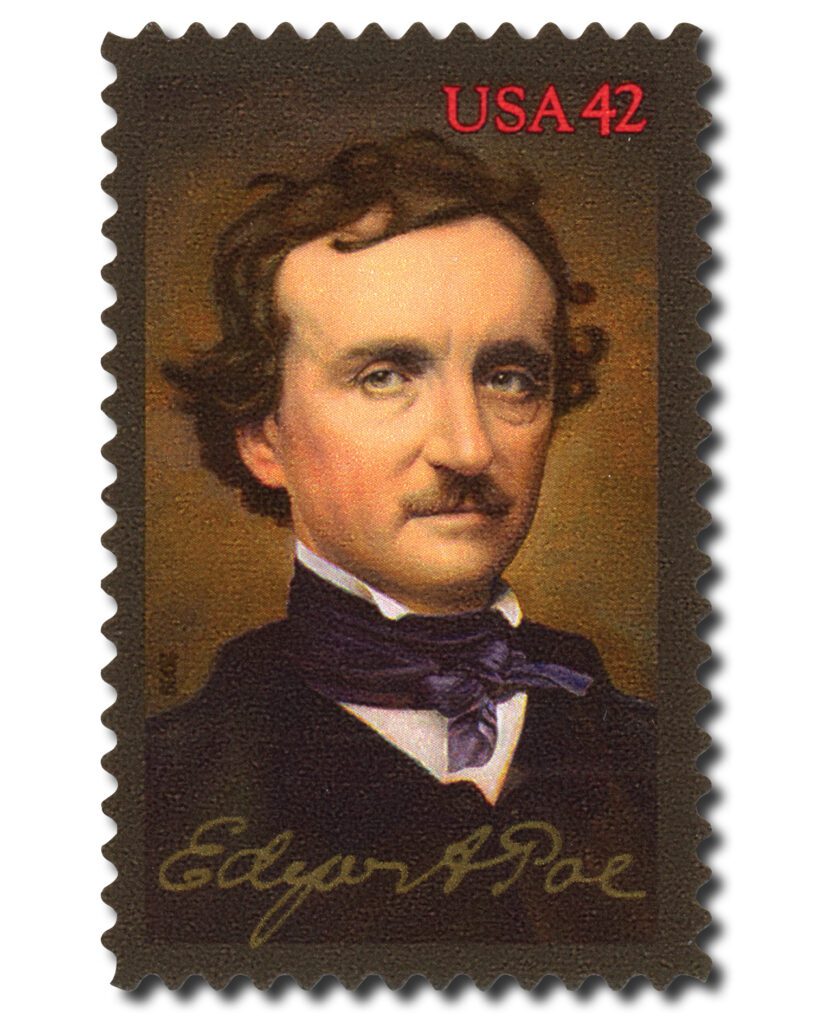Stamps to Haunt You This Halloween
As Halloween approaches, some stamps capture the spirit of the season with eerie imagery and spooky themes. From designs that echo old legends to monsters that have appeared on the silver screen, these stamps can give any collection a haunting twist.
The Legend of Sleepy Hollow
Few American ghost stories are as chilling as Washington Irving’s Legend of Sleepy Hollow. Set in a quiet Hudson Valley village cloaked in shadows, the tale describes an atmosphere where every rustling leaf and whispering wind seems charged with the supernatural. The countryside itself feels alive, with brooding forests, moonlit paths, and a stillness that makes the imagination run wild. Into this uneasy setting steps the most feared figure of all—the Headless Horseman, a spectral rider said to haunt the roads in search of his missing head.
The image of the Horseman thundering through the night has unsettled readers for generations. With his cloak whipping in the wind, a sword flashing in hand, and the eerie absence of a face beneath his helmet, he embodies the terror of the unknown. The story lingers not just because of its folklore roots, but because of the way it transforms the ordinary—dark woods, lonely bridges, empty roads—into places of dread.
Dracula
Bram Stoker’s 1897 novel Dracula introduced a vampire unlike any that had come before, a figure both terrifying and strangely magnetic. His count was not just a bloodthirsty monster but a cunning aristocrat, cloaked in mystery and steeped in centuries of dark history. Stoker’s tale carried readers from eerie Transylvanian castles to fog-shrouded London streets, blending gothic atmosphere with a sense of creeping dread.
What made Stoker’s Dracula so haunting was the way he blurred the line between the civilized and the monstrous. By wrapping horror in the trappings of nobility, he created a villain who could walk undetected among ordinary people, striking without warning. More than a century later, this vision of the vampire still lingers in the imagination, shaping how we picture the lord of the undead.
Classic Movie Monsters
Classic movie monsters have a way of creeping into our imaginations, their shadows stretching long past the silver screen. Bela Lugosi gave Dracula his unforgettable elegance and menace, turning a vampire into a figure of both charm and terror. Boris Karloff’s portrayal of Frankenstein’s monster made audiences tremble with fear and sympathy, his hulking frame hiding a tragic soul. And when he wrapped himself in linen to play the Mummy, he brought an eerie stillness to the creature’s ancient wrath.
Lon Chaney Jr. embodied the Wolf Man’s tortured duality, cursed to prowl under the full moon. His performance captured the raw struggle between man and beast, making the Wolf Man one of horror’s most tragic and enduring figures.
His father, Lon Chaney, used his own masterful makeup skills to transform into the Phantom of the Opera. The result was a ghastly vision with sunken eyes and a skull-like face that shocked audiences when first revealed. What set the Phantom apart was that he was not a supernatural creature but a man twisted by pain and madness. That human element, paired with Chaney’s chilling performance, made him just as haunting as any beast of myth.
These performances helped shape the very image of horror, leaving behind monsters that continue to haunt imaginations long after the curtain fell.
Get a makeshift booklet of the stamps here.
Jack-O’-Lanterns
The jack-o’-lantern has long been a glowing symbol of Halloween, its flickering face casting eerie light on autumn nights. The tradition traces back to Irish folklore, where tales of “Stingy Jack” told of a trickster who wandered the earth with only a carved turnip lantern to light his way. When immigrants brought the custom to America, they found that pumpkins—larger and easier to carve—made the perfect vessel for these haunting creations.
Today, the jack-o’-lantern still carries that blend of mischief and mystery. Some are carved with grinning, friendly faces, while others take on sinister expressions meant to ward off spirits. Whether perched on porches or glowing in windows, their candlelit presence turns the ordinary pumpkin into a beacon of Halloween’s spookiest traditions.
Spooky Silhouettes
Few creatures capture the chill of Halloween night like black cats. With their glowing eyes and silent steps, they’ve long been linked to witches and omens, slipping like shadows across moonlit streets. Spiders add their own unease, spinning webs in dark corners where the unexpected brush of silk can make the bravest shiver.
Ghosts haunt the imagination with their formless presence, whispering of unfinished business and the thin veil between the living and the dead. And then there are bats, winging through the night sky with eerie silence, their sudden swoops stirring visions of vampires lurking in the dark. Each of these figures carries a sense of the uncanny, reminders of the unseen world that makes Halloween feel so deliciously unsettling.
Bats
Bats sweep through the night like living shadows, their wings unfurling in cloaks of velvet and bone. They slip silently along crags and through hollowed trees, their sudden movements breaking the stillness with a chill of unease. Long bound to tales of vampires, they embody the fear of what thrives in darkness, graceful yet unsettling in every flicker of motion.
Their presence feels like an omen, as if the air itself thickens when they pass. With eyes attuned to the dark and cries pitched beyond human hearing, bats seem half-belonging to another realm. In their swift vanishing acts and silent returns, they remind us that the night holds secrets not meant to be fully seen.
Day of the Dead
As the echoes of Halloween night fade, the Day of the Dead emerges with its own haunting beauty. Rooted in ancient Mexican tradition, it blurs the line between the living and the departed, when the veil is said to thin and spirits return to walk among us. Altars glow with candles, marigolds guide the dead with their fiery color, and offerings of food and drink beckon souls back to familiar places.
The imagery is both eerie and enchanting—sugar skulls grinning brightly, skeletons dancing in celebration, and midnight vigils held in candlelit cemeteries. Unlike the frights of Halloween, this observance embraces the presence of spirits, turning the night into a time when the otherworld feels unnervingly close, yet strangely welcome.
Get the imperforate stamps here.
Myths & Legends of the British Isles
Two of the more chilling figures in the 2025 Great Britain Myths & Legends issue are the Black Shuck of East Anglia and Grindylows of Northern England.
Black Shuck is a spectral black dog said to haunt the countryside, his fiery, saucer-like eyes flashing through fog and storm. Folklore tells of the beast turning up unannounced, often as an omen of death or disaster. One of the most famous tales comes from the year 1577, when Black Shuck was said to have wrecked through Saint Mary’s Church in Bungay and Holy Trinity Church in Blythburgh during a thunderstorm—leaving scorch marks on a church door that are still claimed to be visible today.
Grindylows, by contrast, lurk in water: ponds, rivers, and marshes. In Lancashire and Yorkshire especially, these water-sprites (sometimes more demon than fairy) are imagined with long arms, sharp claws, and teeth keen on snatching unsuspecting children who stray too close to the water’s edge. The Grindylow’s danger is less about storm-tossed terror, and more about the lurking, patient threat just out of sight—twisting folklore into warning.
Edgar Allan Poe
Edgar Allan Poe stands as the master architect of literary dread, a writer who found beauty in decay and terror in the human soul. His stories unfold in a world where silence has weight and shadows seem to think. In The Tell-Tale Heart, The Fall of the House of Usher, and The Raven, he led readers through corridors of guilt and grief, where madness whispers just beyond the edge of reason. Few writers have captured so vividly the feeling of being trapped between fear and fascination.
Poe’s own life carried the same chill as his fiction. Orphaned young and haunted by loss, he poured his anguish onto the page, turning pain into something darkly luminous. His voice still echoes through time—steady, mournful, and unrelenting—reminding us that the deepest horror often lies within ourselves.

